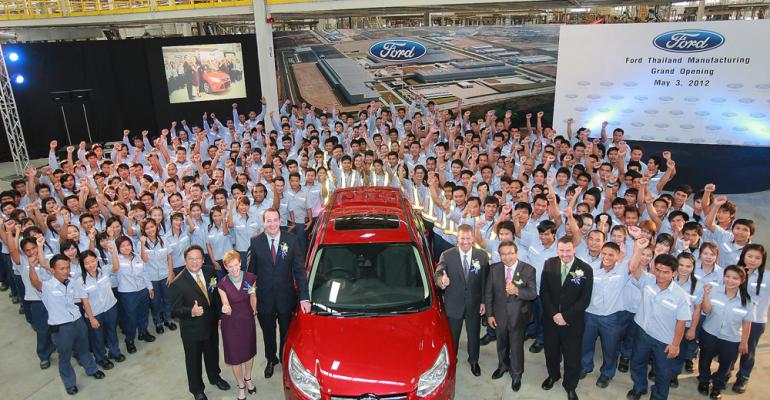RAYONG, THAILAND– Guiding a tour of Ford’s new $450 million auto plant here, Trevor Negus points to a small room off the main floor. “I’ve been spending a lot of time there,” says the manufacturing director of Ford Thailand Mfg.
Staffers at computer terminals occupy the room. Affixed to the walls are rows of printouts showing data on test cars built at the fledging factory.
It is part of a painstaking validation effort to meet precise manufacturing specifications, and ensure all goes right when the plant begins full production this month.
The quality-assurance system is such that the plant will be notified of warranty claims the same day they are filed.
“We have the tools and techniques to make world-class vehicles here, and we are getting ready to do that,” Negus says.
The factory will initially produce 150,000 vehicles a year when it fully is up and running. But it is not at that point yet.
Workers in training are nailing down their assignments, sometimes before managers with stop watches. “We want to make sure people understand their jobs and maintain what I consider the best quality system in the world,” Negus says.
Robots in the body shop and elsewhere are fine-tuned to make sure their movements are exact. In the paint shop, trial-run vehicles undergo an innovative rotational-dip process in which primer, color and clear coats all go on wet and are baked once.
An auto plant coming to life is sort of like a big baby being born; it is amazing to see, and takes a lot of work.
Negus has overseen this project since construction began in 2009 on what he calls a “big block of land.”
The 2.1 million-sq.-ft. (200,000-sq.-m) facility is fully integrated to include stamping, body assembly, paint, trim and final assembly.
Ford says the plant is equipped with state-of-the-art automation that showcases the auto maker’s global manufacturing processes and systems. That includes one of the world’s fastest stamping presses and the latest in robotic technology.
The stamping press can make 15 shots per minute. The die-change time is as quick as six minutes, but during the training period “we’re not at that point,” Negus says.
The new facility has the potential to support up to 11,000 new jobs, including 2,200 direct positions and 8,800 indirect jobs through suppliers and dealer networks.
Currently, 1,600 on-site workers are preparing for the launch of the first model off the line, the new Ford Focus built for both the domestic Thailand market and export to regional countries such as Malaysia, Indonesia, the Philippines and Australia.
The Focus is built on Ford’s global C-plaform. Up to 10 different types of vehicles will be built on the same platform.
“The opening of this new, world-class facility is the latest example of our aggressive growth plan for this region, which represents Ford’s largest industrial expansion in half a century,” says Joe Hinrichs, president of Ford Asia/Pacific and Africa.
It is one of eight new Ford manufacturing facilities that will open by 2015 in Asia Pacific and Africa. “Ford Thailand Mfg. will allow us to meet the enormous growth in vehicle demand across this region in the coming years,” Hinrichs says.
Thailand, China and India are global production and export hubs for Ford.
The plant is Ford’s second in Thailand. The first, a joint venture with Mazda, is an AutoAlliance facility that builds Ranger pickup trucks and Fiesta subcompact cars as well as Mazda’s BT-50 pickup and Mazda2 and Mazda3 cars.
The new factory is designed for maximum flexibility and eventually will be capable of producing six different vehicles simultaneously.
“This is a beautiful plant, says Negus, noting, among other things, its airiness, cleanliness and openness. “I grew up in plants where parts next to the line were stacked up so high you couldn’t see past them.”
That is no longer the case because of modern just-in-time inventory and so-called kitting, he says. “You don’t have stacked parts, you have kits.”
Those are boxes containing four or five parts that are presorted in a warehouse. The assembled kits are coded to coincide with particular vehicles under assembly.
“It promotes quality because it allows the operator to focus on putting a part on right, rather than focus on what right part to pick from a stack of them,” Negus says.
A native of Australia, he is an electrical engineer who previously supervised the construction and opening of Ford plants in China and the U.K. “I’m really proud of this facility,” he says.
It is satisfying to build an auto plant, Negus tells WardsAuto. “But it really gets exciting when we start making cars here.”




